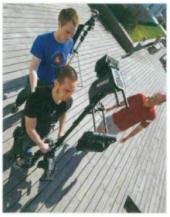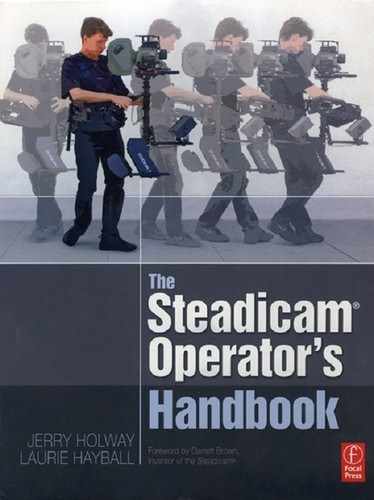Flying with a motorized stage
General balancing without a motorized stags
A Steadicam should be balanced and trimmed for the shot. If the process is cumbersome, the Steadicam's balance is not likely to be tweaked to perfection.
Old Steadicam models like the IIIA or ProVid were particularly annoying to rebalance. They had a rack and pinion system for adjusting fore and aft balance and a separate screw-type locking mechanism. Operators had to reach up, loosen the dovetail lock,disturb the balance, rack the dovetail, test for balance, and, if it was good enough, tighten the dovetail lock and settle the sled to its new balance. Then maybe the DP wanted you to boom up a few inches, so your precious trim was no longer valid.
With this setup, it should be no surprise that often operators would just cither muscle their way through the shot or tilt a battery or monitor to get better balance.
Stages with micrometer screw drives (like the original Panaglide®) only require the operator to reach up and turn a knob. It's a much simpler and quicker process to get a nominal balance than a rack and pinion system. However, many shots have sections that would benefit from a different balance than the nominal, but manual re-trimming, like manually focusing the lens, will disturb the image.
From the beginning, it was clear that a wireless focus system was crucial for Steadicam operating. It also should have been clear that a motorized stage would be a great help for Steadicam operators. As Garrett Brown says, “Not having a motorized stage is like flying an airplane and having to land to change the airplane's trim.”
As the requirements of the shot change,
the Steadicam should be rebalanced.

Remote control

Motor speed adjustments
Using the motorized stage is extremely simple. There are four buttons on the remote control. Pushing one causes the stage to move, changing the balance of the rig. Releasing the button, or reaching the end of the stage travel, causes the motor to stop. Motor speed is set via pots on the stage.
Pre-shot balancing with a motorized stage
Because the operator does not reach up and touch the stage, nor does he change his posture or the camera position, balancing with the motors is both quicker and more precise.
There are also few, if any, distractions to others on the set. Tweaking the balance can be done without any apparent movement of the operator (unless you are concentrating onhis thumb). This invisible tweaking is extremely important at the head of shots, where the overt fussing of the steadicam operator can be as distracting to an actor as slamming the slate shut in front of his face.
In low mode, manual tweaking often requires the operator to grossly reorient the sled just to reach the manual controls, guess at the new setting, then reframe, and evaluate what has happened. There's a lot of wasted time and effort - plus a lot of fuss and bother on the set. Motorized balancing eliminates all that.
Long mode configurations are also difficult to balance manually, both on the stand and while wearing the rig. Sometimes in extreme low mode it's impossible for the operator to reach the stage, and the only way to manually adjust the stage is to dock the rig or have an assistant kneel down and tweak the balance. Neither is pretty or efficient.

Jakob Bonfils' motorized mod for IIIA stage. The motor drives the stage when the Arriflex BL III camera runs, compensating for the side to side film travel in the magazines.

In-shot balancing
Non-motorized stages can be balanced only one way — usually for the beginning or end of the shot, possibly for an important moment, or perhaps for some generally useful trim. But with a motorized stage, the operator can constantly adjust the trim for the best possible balance for every part of the shot.
It does take a few more brain cells to keep things straight: navigate, frame, bubble, push the remote, frame, navigate. But if you can add the technique to your repertoire, it will make your operating more precise.
If the requisite brain cells can't be summoned for the task, the remote transmitter can be handed off to an assistant who can make premeditated balance changes during the shot for you.
Side to side balancing is also possible — making shooting Dutch angles easier and more precise, as Larry McConkey did in Snake Eyes (see page 140).
The “smart” motorized stage
One annoyance with the original motorized stage: during the shot, it was not easy to move the stage to a specific trim point and then return to the nominal trim. The operator typically counted the number of seconds a button was pushed, and counted some other number to get the stage back to a nominal trim. The final trimming was done by feel as the shot continued, which took time and effort. Although a motorized stage was a huge improvement over non-motorized stages, the lack of precision and repeatability was a limiting factor.

In the smart stage, a microprocessor keeps track of the stage position. In addition to tot four “move” buttons on the remote, there are several new buttons that move the stage to precise, predetermined positions for specific sections of the shot.
Normally, the various “way points” or trim positions are programmed during rehearsal. The operator gets the sled to the proper balance, and then pushes and holds one of the go to buttons for several seconds to set the trim position. One go to button is set for the nominal trim, so returning to the normal balance is easy and automatic.
It also is possible to re-program any button on the fly, even in the middle of a shot -once again if the old brain can manage to keep track of things.

These go to buttons also make it easy for an assistant to change the rig's balance for the operator during the shot. No longer does he have to be in a specific position to count the revolutions of the knobs on the stage — because he doesn't need to count.
The smart stage also has a button on the nose box for “move stage to center.” This button centers the stage in both axes, which is extremely useful for new setups.
Level Assist™
The other thing that becomes possible with a smart level and a smart motorized stage is what we call Level Assist™. This is a system that takes the level information and gently moves the camera mounting stage side to side to help you keep the stage upright. The amount of help, if any, you get is entirely under your control, and the system can be turned on and off during a shot via the gimbal transmitter. Whenever you are level, the stage returns to the nominal side to side balance position.
If this sounds like a training-wheels gimmick for the inexperienced operator (and it might work that way), I can only offer this bit of history:
Way back in 1993 or 1994 (at least a year before the advent of the Master Series™ and the first motorized stage), Garrett Brown chased the idea of a level assist system. In one early test he hooked up a Heden focus motor to drive a Model IIIA stage side to side.
Garrett invited me out to the farm and each of us tried operating a back and forth, side to side tracking shot, while the other operated a wireless remote (the venerable Seitz), and stood in a position to judge if the rig was level. If the Steadicam went off level, the “level assistant” would turn the remote to change the side to side balance, trying to right the sled.
I was very dubious of the whole scheme. I suspected the action of the motors would be both annoying and distracting. The experiment proved a bit embarrassing. With a little help from Garrett, my shots were noticeably more level. Really embarrassing, actually. Okay. It was humiliating!
It only took 15 years to replace “the gifted assistant in the right spot and paying attention” with the right microchips, sensors, and software to get a proper level assist system working.
Note: If you have a motorized stage, duplicate this experiment by handing off the remote to an assistant.
